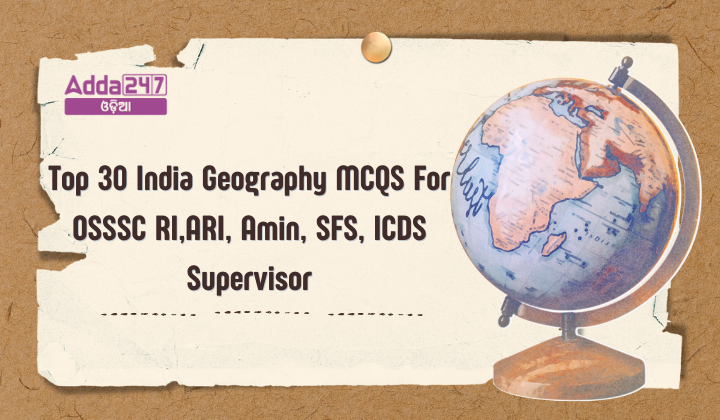Geography plays a crucial role in various competitive exams, including OSSSC RI, ARI, AMIN, SFS, and ICDS Supervisor. To assist candidates in their preparation, we have compiled a set of 30 Multiple Choice Questions (MCQs) at a moderate difficulty level. Each question is accompanied by a correct answer to enhance your geographical knowledge and better prepare you for the upcoming exams.
Top 30 India Geography MCQs For OSSSC RI,ARI, Amin, SFS, ICDS Supervisor
- Why are the Western Ghats called Ghats?
(a) Because they have numerous temples
(b) Because they are a series of mountain passes
(c) Because they are located near the coast
(d) Because they are older than the Himalayas
Ans. (b) Because they are a series of mountain passes - Why are the Western Ghats important?
(a) They have a high population density
(b) They contain large deposits of minerals
(c) They perform important hydrological and watershed functions
(d) They are a famous tourist destination
Ans. (c) They perform important hydrological and watershed functions - How many states are covered by the Western Ghats?
(a) Four
(b) Five
(c) Six
(d) Seven
Ans. (c) Six - What is another name given to the Western Ghats?
(a) Sahyadri
(b) Vindhyas
(c) Aravalli
(d) Shivalik
Ans. (a) Sahyadri - Are the Western Ghats a continuous or discontinuous range of mountains?
(a) Continuous
(b) Discontinuous
(c) Both continuous and discontinuous
(d) None of the above
Ans. (a) Continuous - What is the speciality of Western Ghats?
(a) High altitude
(b) High biodiversity and endemism
(c) Numerous rivers
(d) Unique soil type
Ans. (b) High biodiversity and endemism - What kind of forests are found in the Western Ghats?
(a) Mangrove forests
(b) Temperate forests
(c) Evergreen and deciduous forests
(d) Coniferous forests
Ans. (c) Evergreen and deciduous forests - How were the Western Ghats formed?
(a) Volcanic activity
(b) Erosion of the Gondwana supercontinent
(c) Collision of tectonic plates
(d) Deposition of sediments
Ans. (b) Erosion of the Gondwana supercontinent - Which is the highest peak of Western Ghats?
(a) Doddabetta
(b) Mullayanagiri
(c) Anamudi
(d) Agasthyamalai
Ans. (c) Anamudi - Are the Western Ghats older than the Himalayas?
(a) Yes
(b) No
(c) They are of the same age
(d) None of the above
Ans. (a) Yes - What is the new national highway number for the old NH 1 A and NH 1 D?
(a) NH 2
(b) NH 1
(c) NH 4
(d) NH 19
Answer: (b) NH 1 - NH 1 B has been renumbered as which new national highway?
(a) NH 244
(b) NH 223
(c) NH 50
(d) NH 114
Answer: (a) NH 244 - Which new national highway number corresponds to the old NH 2?
(a) NH 50
(b) NH 19
(c) NH 217
(d) NH 748
Answer: (b) NH 19 - NH 2A is now known as which new national highway?
(a) NH 60
(b) NH 519
(c) NH 4
(d) NH 348
Answer: (b) NH 519 - What is the new number for the old NH 2B?
(a) NH 223
(b) NH 114
(c) NH 5
(d) NH 60
Answer: (b) NH 114 - NH 4 A has been renumbered as which new national highway?
(a) NH 165
(b) NH 748
(c) NH 217
(d) NH 6
Answer: (b) NH 748 - NH 4 B corresponds to which new national highway number?
(a) NH 348
(b) NH 5
(c) NH 6
(d) NH 223
Answer: (a) NH 348 - What is the new number for the old NH 5?
(a) NH 6
(b) NH 49
(c) NH 60
(d) NH 16
Answer: (d) NH 16 - NH 6 has been renumbered to which new highway?
(a) NH 60
(b) NH 223
(c) NH 5
(d) NH 4
Answer: (a) NH 60 - NH 16 (part of the Golden Quadrilateral) is renumbered from which old highway?
(a) NH 217
(b) NH 5
(c) NH 60
(d) NH 2
Answer: (b) NH 5 - Which of the following plains is characterized by gravel and un-assorted sediment deposits and is generally unsuitable for cultivation?
(a) The Tarai Tract
(b) The Bhangar Plains
(c) The Khadar Plains
(d) The Bhabar Plains
Answer: (d) The Bhabar Plains - Which physiographic division of the Great North Indian Plains is known for its high rainfall, excessive humidity, and thick forests, making it rich in humus and organic matter?
(a) The Tarai Tract
(b) The Delta Plains
(c) The Bhangar Plains
(d) The Bhabar Plains
Answer: (a) The Tarai Tract - What is the main characteristic of the Khadar Plains?
(a) They are older alluvial plains.
(b) They consist of gravel and un-assorted sediments.
(c) They are enriched by fresh deposits of silt every year.
(d) They are covered with thick forests.
Answer: (c) They are enriched by fresh deposits of silt every year. - Which of the following areas is known for containing calcium carbonate nodules called ‘Kankars’?
(a) The Khadar Plains
(b) The Bhabar Plains
(c) The Delta Plains
(d) The Bhangar Plains
Answer: (d) The Bhangar Plains - The Delta Plains are an extension of which type of land?
(a) The Tarai Tract
(b) The Khadar Plains
(c) The Bhangar Plains
(d) The Bhabar Plains
Answer: (b) The Khadar Plains - In which division of the Great North Indian Plains is the soil enriched with humus and suitable for crops like wheat, rice, and maize?
(a) The Tarai Tract
(b) The Khadar Plains
(c) The Bhabar Plains
(d) The Bhangar Plains
Answer: (b) The Khadar Plains - The Bhangar Plains were formed during which geological period?
(a) Pleistocene
(b) Holocene
(c) Miocene
(d) Eocene
Answer: (a) Pleistocene - What are the ‘Chars’ and ‘Bills’ in the context of the Delta Plains?
(a) Types of soil
(b) Old and new mud deposits
(c) Uplands and marshy areas
(d) Types of forests
Answer: (c) Uplands and marshy areas - Which physiographic division is described as a marshy tract with a malarial climate and is known for its rich flora and fauna?
(a) The Tarai Tract
(b) The Bhabar Plains
(c) The Bhangar Plains
(d) The Delta Plains
Answer: (a) The Tarai Tract - Which of the following plains is primarily used for the cultivation of crops such as sugarcane, rice, wheat, maize, and oilseeds?
(a) The Bhabar Plains
(b) The Delta Plains
(c) The Khadar Plains
(d) The Bhangar Plains
Answer: (c) The Khadar Plainsy










